Juan Negrin. A physician and a prime minister (1892-1956)
|
Juan Negrín. A physician and a
prime minister (1892-1956)
From 24th January to 30th
March 2008
Estudi General Exhibition Room - La Nau
From
Tuesday to Saturday, from 10 to 13.30 and from 16 to 20 h.
Sunday, from 10 to 14 h.
|
|
|
|
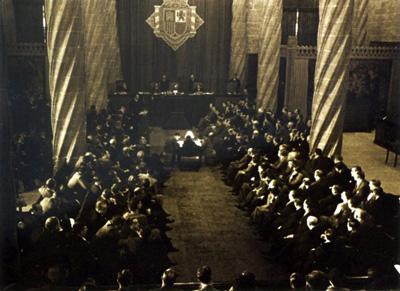
Walter Reuter.
Spanish parliament session at Valencia’s Silk Exchange,
1 October 1937. Juan Negrín, the president of the
government, addresses the members of parliament. |
|
|
|
Organised, produced and promoted by:
Sociedad Estatal de Conmemoraciones Culturales and
Universitat de València
Collaborators:
Fundación Pablo Iglesias
Fundación Juan Negrín
Introduction
The 50th anniversary of the death of Juan Negrín López
was in November 2006. He was an outstanding
physiologist, a socialist, and the last prime minister
of the 2nd Spanish Republic, between 1937 and 1945.
Juan Negrín is said to have been a great figure but one
neglected in Spanish socialism history. Until recently
no literature on his figure had been compiled. This
situation has been partly made up for by a book (Ricardo
Miralles, Juan Negrín, La República en guerra, Temas de
Hoy, Madrid, 2003) focused on his most important period,
the Civil War, and by a short biography by Gabriel
Jackson in Ediciones B (Gabriel Jackson and
Víctor Alba, Juan Negrín).
According to the exhibition’s curator, Ricardo Miralles,
“the biography of Juan Negrín (1892-1956) continues to
raise controversy, despite the many years since his
death. In his time, his supporters underlined his high
stature as a statesman, while his detractors reduced his
qualities as a ruler to nothing, portraying him as the
worst traitor secretively devoted to Communism, a
spurious cause. For today’s historians, both flattering
defence and nonnegotiable condemnation lead any attempt
of veracity on Negrín's figure to no results whatsoever.
Indeed, the difficulties in approaching his figure –an
unnecessary outcome of the complex historical times he
lived- cannot admit a simplification to belligerent
schemas. That’s why I think that insisting on the good
or bad qualities of the character is a totally unfertile
intellectual exercise. Even so, debates are always
better than ignorance or silence. Silence about Negrín
was indeed made absolute as from his death in Paris in
1956, 50 years ago".
Presented at the University of Valencia, the exhibition
aims to repair this historical oblivion and mutilated
memory and to provide new generations with information
that was missing to date. |
|
|
|
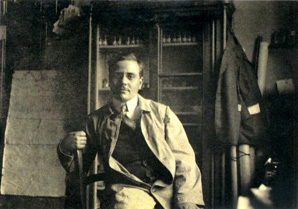
Juan Negrín at the laboratory of the Physiology
Institute of Leipzig. |
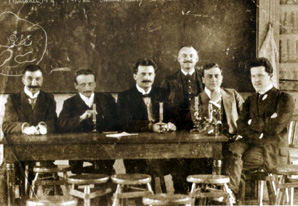
Juan Negrín in Leipzig, Germany, with colleagues from
the Physiology Institute. |
|
|
|
Summary of the Exhibition
Juan Negrín López was born in Las Palmas de Gran Canaria
on 3rd February 1892, in a well-off family. After
completing his high education, when he was just 16, he
travelled to Germany to do a medical degree. He
completed his PhD at the University of Leipzig. Negrín
introduced in Spain the latest research in physiology
together with Santiago Ramón y Cajal, who recommended
him for the commission and management of the Physiology
Laboratory, at the basement of the Residencia de
Estudiantes of Madrid. After validating his studies
in Spain, in March 1922, when he was 30, he became
Professor in Physiology by Madrid's Central University.
In the development of his post in the medical college,
he organised the physiology lab.
Negrín joined the Spanish Socialist Party in May 1929
and, from the proclamation of the Republic, he
concentrated on politics, dropping out from medical
practice and academic activity. He was elected member of
parliament during the three republican terms, aligning
himself with the “central” fraction of the party, headed
by Indalecio Prieto, a very close friend to him until
the end of the civil war.
At the onset of the fratricidal conflict, Negrín was
appointed Chancellor of the Exchequer under the rule of
Francisco Largo Caballero. His name has been associated
with the transfer of gold reserves from the Bank of
Spain to the Soviet Union ever since. The black legend
on "Moscow's gold" started then, Negrín being turned
into the servile executor of orders from Moscow. The
first government of Juan Negrín was constituted on 17
May 1937. No matter how much Azaña’s personal diary made
clear that it was him personally who gave Negrín the
power, the chapter about his promotion to prime minister
has been linked to murky business from Moscow. |
|
|
|
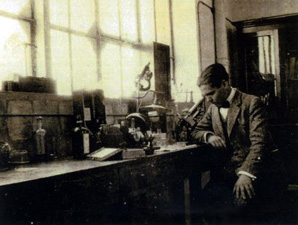
Federico García Lorca looking through the microscope. |
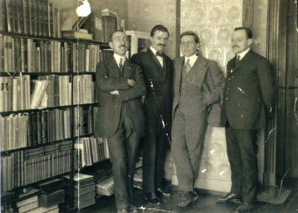
From left to right, Julio Guzmán, Enrique Moles, Juan
Negrín and another friend in Leipzig, 1911. |
|
|
|
With the passing of time and the republic defeats in the
battlefield, Manuel Azaña and Juan Negrín fell out.
Azaña himself explained later the difference that
separated his concept of resistance politics at the time
from that of his prime minister. According to him, the
Republic’s dilemma was never “resistance or surrender”.
The difference was between “resisting is winning /
resisting is the only possible policy”, which Negrín
supported, and his very conviction that the war was
inevitably lost from the start and, consequently,
“resisting had to be a way of reaching the peace". Both
conceptions turned incompatible.
Under the internationalisation circumstances of the
civil war, the real materialisation of resisting until
the end -advocated by Negrín- would have been impossible
without foreign help. As a consequence, Negrín’s policy
led to international dependence on the USSR and the
unprecedented protagonism of the Spanish Communist
Party.
In the long run, the identification of the Communist
Party with the resistance policy fostered by Negrín
caused the remaining political forces -parallel to the
waning possibilities of the Republic- to reject the
communists (rather openly in the end) and subsequently
Negrín. Therefore, with successive military defeats, the
internal political homogeneity of the government and the
Popular Front first collapsed and finally blew up.
In fact, the fundamental problem, loyalty-wise, was the
evolution of the war and the fact that this was
unfavourable to the Republic all along. As military
defeats were taken in, in some political forces
–republicans, nationalists, and socialists opposed to
the Negrinist faction of the Socialist Party- but
also among the military, the idea spread that it was
them who had to take over the Republic’s government,
perhaps imagining a possible understanding with the
enemy to put an end to war, getting rid of Negrín, and
having France and Great Britain as mediators. None of
this was possible. With or without Negrín, Franco’s
determination was always of total victory and
consequently of unconditional defeat.
In his immediate exile, Negrín did not manage to control
the centrifugal tendencies of republicans and
socialists, and his government -in office until 1945-
was contested by different sectors. It is unavoidable to
say that Indalecio Prieto (a genuine political mentor to
Negrín in the 1930s) became his most implacable critic.
On Negrín’s death, however, he deeply regretted not
having made up with him. |
|
|
|
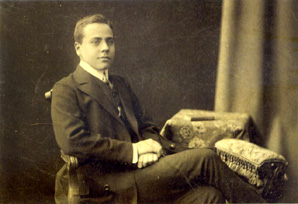
14-year old Juan Negrín, in Germany. |
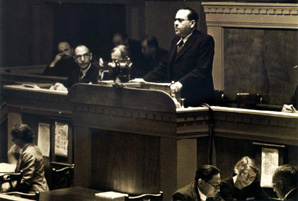
Negrín reporting on the intervention of fascist forces
in the Spanish War, General Assembly of the League of
Nations, Geneva. 14 September 1937 |
|
|
|
Catalogue
The exhibition is complemented by a catalogue with
materials that support the exhibits and which include a
number of scientific papers written by the best
specialists ex novo. This is the list of the
articles:
Ricardo Miralles, Juan Negrín, un socialista silenciado
Josep Lluís Barona, Negrín, médico fisiólogo
Julio Aróstegui, La guerra civil española. Conflicto
moderno, solución antigua.
Enrique Moradiellos, El acceso de Juan Negrín a la
jefatura de gobierno y la reconstrucción del Estado: su
primer año
Ángel Viñas, Juan Negrín, la cuestión del oro y la
economía de guerra repulicana
Gerald Howson, Armas para la República Española
Daniel Kowalsky, Los rusos en España
Antonio Elorza y Marta Bizcarrondo, Juan Negrín, entre
dos comunismos
Michael Alpert, Negrín y el ejército
Ricardo Miralles, Diplomacia para una guerra
Enric Ucelay-Da Cal, Negrín en Cataluña: nadie perdona a
un perdedor
Santos Juliá, Azaña y Negrín con Madrid al fondo
Helen Graham, Negrín contra Prieto: una crisis en tres
actos
Paul Preston, Razones para la resistencia: la represión
franquista en zona nacional
Gabriel Cardona, Las razones de Negrín para resistir
Ángel Bahamonde Magro, Casado versus Negrín. El
síndrome del abrazo de Vergara
Juan Francisco Fuentes, Negrín y la división del
socialismo español en el exilio
Sergio Millares, Los papeles de Negrín
“Yo
lo conocí”, a selection of short texts by: Carmen
Negrín, Santiago Carrillo, Francisco Ayala, Ramón
Lamoneda y Marxina Lamoneda, Francisco Guerra, Aurora
Arnáiz Amigo, Eulalio Ferrer and Juan Martín Tundidor
López. |
|
|
|
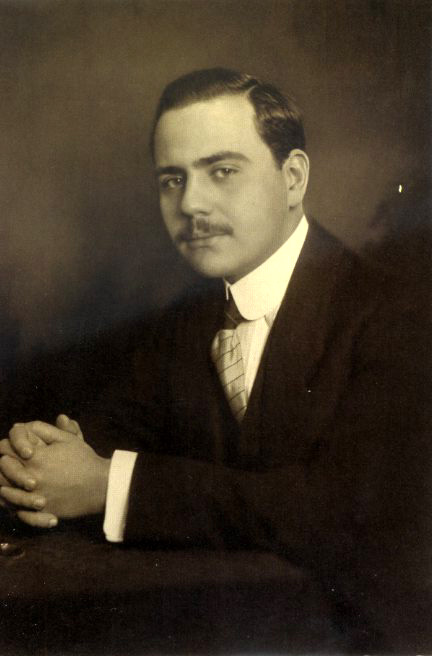
Portrait of Juan Negrín during his stay in Germany.
Photographer: Ernst Sandau, Berlin. |
|
|
|
Documentary produced on the occasion of the exhibition
TITLE
Juan Negrín.
Resistir es vencer.
CO-PRODUCED BY
SECC+TVE+Fundación Pablo Iglesias
YEAR
2006
SYNOPSIS
Juan Negrín, a scientist and
a politician, was the President of the last Government
of the 2nd Republic of Spain. Apart from a human and
professional portrait, the documentary covers the famous
story of Moscow’s Gold and the last days of the Civil
War, including Segismundo Casado’s coup d'état.
LENGTH
52 min
FORMAT
Digital Betacam 16:9/DVD
GENRE
Documentary
Curator
Ricardo Miralles, Contemporary History Professor from
the University of the Basque Country, is a specialist in
the History of the Worker Movement and Spanish Socialism
in particular. Among other works, he is the author of:
El
socialismo vasco durante la II República, Bilbao 1988;
Indalecio Prieto. Textos escogidos, Oviedo, 1999; Juan
Negrín. El hombre necesario, Las Palmas de Gran Canaria,
1996; and Juan Negrín. La República en guerra, Madrid
2003.
He has also researched on International Affairs History,
with the publication Equilibrio, hegemonía y reparto.
Historia de las relaciones internacionales entre 1890 y
1945; He has published numerous papers on international
politics during the Civil War period in different
national and international journals.
For more information:
http://www.secc.es/ficha_actividades.cfm?id=1040 |
|
|
|

Negrín in France, 1950s; his heart condition was already
serious. |
|
|
|
|